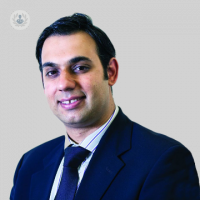Don't stick your neck out for cervical myelopathy
Written by:Cervical myelopathy can be described as an injury to the spinal cord usually due to compression of the cord from degenerative changes (cervical spondylosis) or trauma. Patients can present with a wide variety of symptoms, which can be associated with neck pain or arm pain from trapped nerves.
It’s useful to know more about cervical myelopathy, as it can be caused by degenerative changes, even in relatively young adults. Mr Imran Liaquat, a leading consultant neurosurgeon, addresses common features in this detailed and informative article.

What are the symptoms of cervical myelopathy?
Symptoms of cervical myelopathy can be of a variable nature. Nevertheless, the most common symptoms include: weakness in the arms; clumsiness, numbness and tingling in the arms and hands, as well as heaviness and weakness of hips or lower legs. In addition, patients can experience poor coordination, deterioration in mobility, problems with control of bladder, bowel and sexual function. Furthermore, when examined patients often have become stiffer when moving and develop exaggerated reflexes. Finally, the degenerative processes that cause cervical myelopathy can also cause mild to severe chronic neck pain, as well as sharp stabbing arm pain.
What causes cervical myelopathy?
Cervical myelopathy is a generic term that really, states there is disease or injury of the spinal cord. That's what the myelopathy represents.
However, the most common cause for cervical myelopathy is usually from external compression of the spinal cord from degenerative changes. The biological process that causes these degenerative changes is known as cervical spondylosis. Cervical spondylosis occurs in every adult as they age. It is part of the normal ageing process, however sometimes the spondylosis becomes so pronounced in individuals that it can then cause pressure on the cord.
The cervical spondylosis itself usually consists of:
- The development of bony spurs within the vertebrae
- Small disc bulges
- Enlargement or thickening of ligaments and joints that help maintain alignment and movement of the spine
These changes combine to encroach on and narrow the spinal canal diameter, which is the space through which the spinal cord passes. If the spinal canal diameter is significantly reduced, then this can cause external pressure on the spinal cord. This pressure can then result in symptoms of Cervical Myelopathy.
Is cervical myelopathy painful?
Most patients with cervical myelopathy do not have pain in their arms or legs. This is because the spinal cord itself doesn't really have any pain receptors so when you have pressure on the spinal cord, you don't develop pain. However, the spinal cord carries pain signals from peripheral limbs to the brain and so very occasionally patients may develop some spontaneous burning pain over their torso or limbs, due to disruption of the pathways in the spinal cord that transmit these pain signals from the extremities and torso to the brain. In addition, the degenerative process that causes myelopathy can cause chronic mechanical neck pain. The neck pain arises from the bony and soft tissue structures (ligaments/muscles) that form the spinal column.
Sometimes the process that causes cervical myelopathy may also cause compression of a nerve root, and patients can get sharp, stabbing, burning pain as a result of pressure on that nerve root.
However, the symptoms from that pressure on the nerve root is known as cervical radiculopathy. In that scenario, we tend to describe patients as having cervical myeloradiculopathy, which means they've got both spinal cord compression and a trapped nerve. As rule of thumb, cervical myelopathy does not cause pain.
Can cervical myelopathy be cured?
Cervical myelopathy caused by degenerative changes cannot be cured. The aim of surgery in a patient with cervical myelopathy is to stop further ‘neurological’ deterioration in their function. Surgery cannot reverse neurological function back to normal. Perhaps one in two patients, particularly if they are young, may notice some mild improvement in function. For example, if some patients have developed some weakness and/or loss of feeling in the arms and legs, then one in two might feel there's been some improvement in function after surgery. It usually takes six months to notice if there is a sustained improvement.
However, if a patient in a follow-up clinic after surgery for Cervical Myelopathy stated that they have not noticed any further deterioration in neurological function, then that would be deemed a successful operation.
Is cervical myelopathy surgery safe?
In general terms, surgery is challenging and always carries risks but for the majority of patients, surgery would be relatively safe. There are complications from surgery that all patients have to be counselled on before any intervention.
In general terms, the biggest risk that you have with surgery for the condition is; there is somewhere between a one to five percent chance of making their cervical myelopathy symptoms worse, whilst doing the surgery and trying to improve their function.
How long does it take to recover after cervical myelopathy surgery?
This can vary depending on patients. If someone's had a short-lived history of cervical myelopathy and they undergo surgery and they're young, for example in their twenties, thirties or forties, they can often make quite a rapid recovery, even within a few weeks to months.
Other patients who, for example, are more elderly and have maybe other co-morbidities such as diabetes, heart disease and other conditions, often make slower progress.
What we usually state to patients is that about 80 per cent of recovery happens in the first six months and the last twenty per cent of recovery happens in the next 18 months. So, patients can improve for up to two years and what they're left with at the end of two years, is the maximum function they're going to have.
Treating cervical myelopathy doesn’t have to be a pain in the neck. Visit Mr Liaquat’s Top Doctor’s profile to arrange an appointment with this expert specialist, at your convenience.


